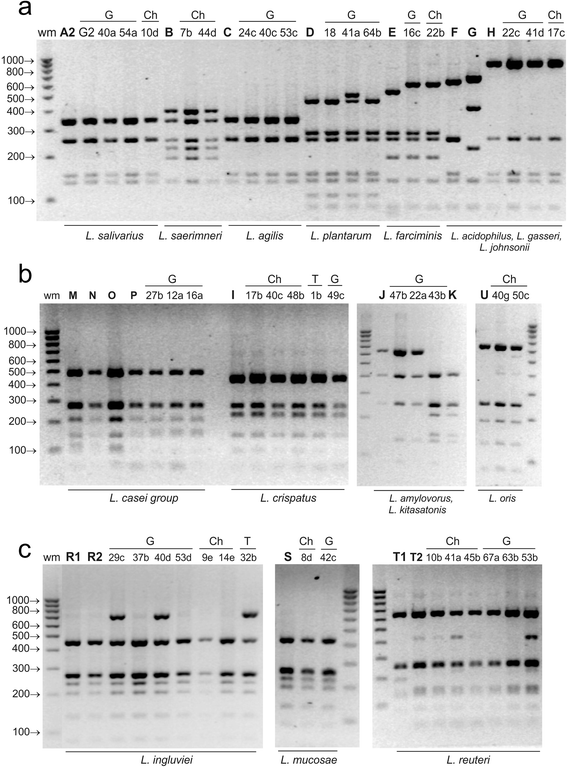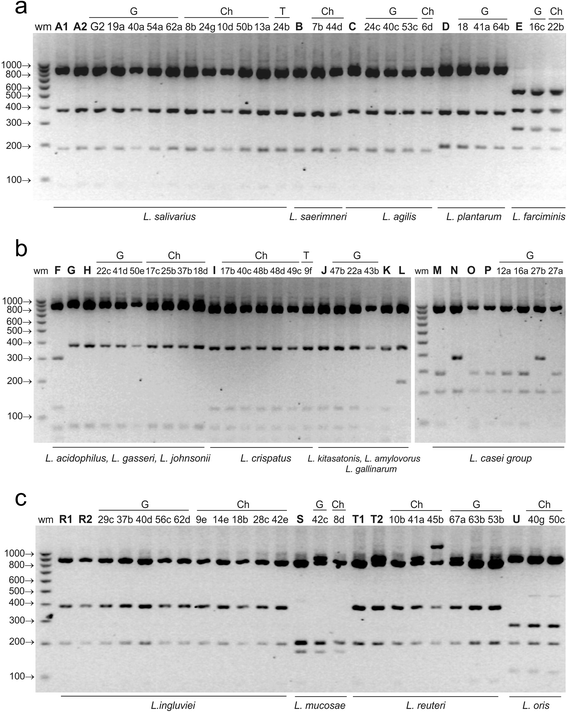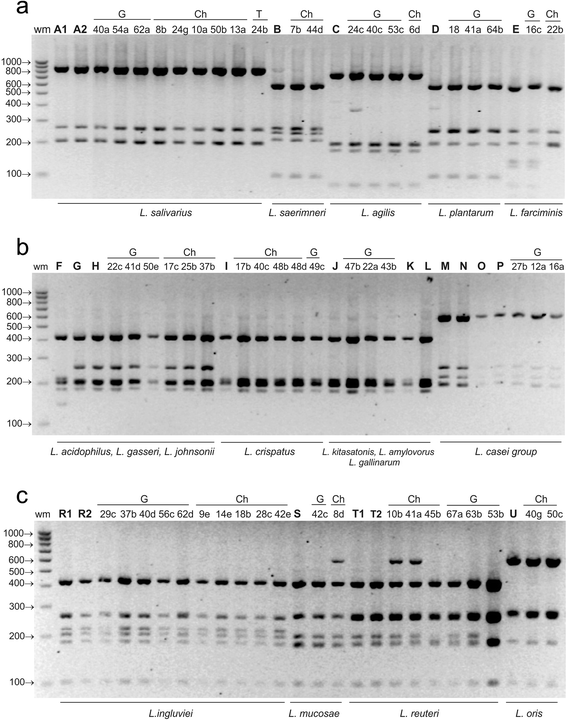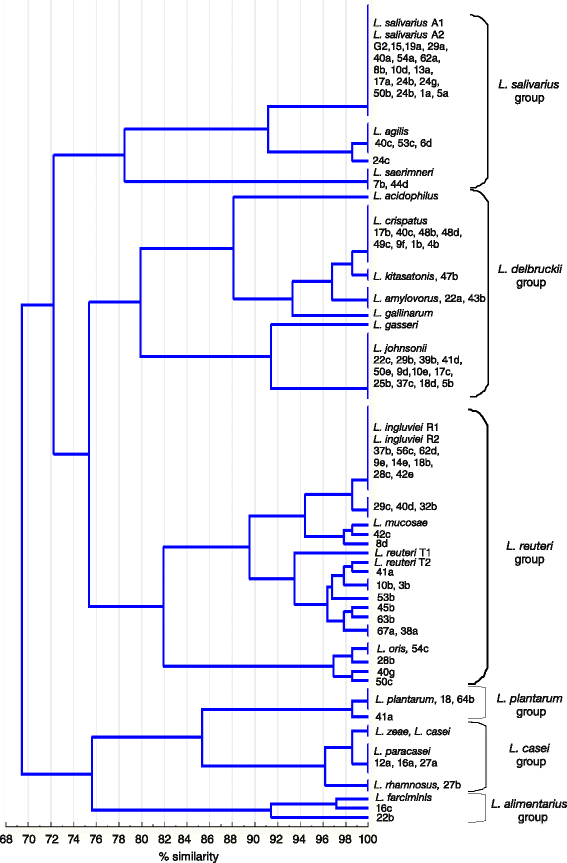16S-ARDRA and MALDI-TOF mass spectrometry as tools for identification of Lactobacillus bacteria isolated from poultry
- PMID: 27296852
- PMCID: PMC4906599
- DOI: 10.1186/s12866-016-0732-5
16S-ARDRA and MALDI-TOF mass spectrometry as tools for identification of Lactobacillus bacteria isolated from poultry
Abstract
Background: The objective of our study is to evaluate the potential use of Amplified 16S Ribosomal DNA Restriction Analysis (16S-ARDRA) and MALDI-TOF mass spectrometry (MS) as methods for species identification of Lactobacillus strains in poultry.
Results: A total of 80 Lactobacillus strains isolated from the cloaca of chicken, geese and turkeys were identified to the species level by MALDI-TOF MS (on-plate extraction method) and 16S-ARDRA. The two techniques produced comparable classification results, some of which were additionally confirmed by sequencing of 16S rDNA. MALDI-TOF MS enabled rapid species identification but produced more than one reliable identification result for 16.25 % of examined strains (mainly of the species L. johnsonii). For 30 % of isolates intermediate log(scores) of 1.70-1.99 were obtained, indicating correct genus identification but only presumptive species identification. The 16S-ARDRA protocol was based on digestion of 16S rDNA with the restriction enzymes MseI, HinfI, MboI and AluI. This technique was able to distinguish 17 of the 19 Lactobacillus reference species tested and enabled identification of all 80 wild isolates. L. salivarius dominated among the 15 recognized species, followed by L. johnsonii and L. ingluviei.
Conclusions: The MALDI-TOF MS and 16S-ARDRA assays are valuable tools for the identification of avian lactobacilli to the species level. MALDI-TOF MS is a fast, simple and cost-effective technique, and despite generating a high percentage of results with a log(score) <2.00, the on-plate extraction method is characterized by high-performance. For samples for which Biotyper produces more than one reliable result, MALDI-TOF MS must be used in combination with genotypic techniques to achieve unambiguous results. 16S-ARDRA is simple, repetitive method with high power of discrimination, whose sole limitation is its inability to discriminate between species with very high 16S rDNA sequence homology, such as L. casei and L. zeae. The assays can be used for discrimination of Lactobacillus bacteria from different habitats.
Keywords: 16S rDNA; ARDRA; Identification; Lactic acid bacteria; Lactobacillus; MALDI-TOF MS; Poultry.
Figures





Similar articles
-
Rapid species-level identification of vaginal and oral lactobacilli using MALDI-TOF MS analysis and 16S rDNA sequencing.BMC Microbiol. 2014 Dec 14;14:312. doi: 10.1186/s12866-014-0312-5. BMC Microbiol. 2014. PMID: 25495549 Free PMC article.
-
Identification of Lactobacillus strains of goose origin using MALDI-TOF mass spectrometry and 16S-23S rDNA intergenic spacer PCR analysis.Res Microbiol. 2014 Apr;165(3):190-201. doi: 10.1016/j.resmic.2014.02.003. Epub 2014 Mar 5. Res Microbiol. 2014. PMID: 24607713
-
Identification of lactobacilli isolated from food by genotypic methods and MALDI-TOF MS.Int J Food Microbiol. 2012 Oct 1;159(2):107-14. doi: 10.1016/j.ijfoodmicro.2012.07.029. Epub 2012 Aug 10. Int J Food Microbiol. 2012. PMID: 23072695
-
Current developments to use linear MALDI-TOF spectra for the identification and typing of bacteria and the characterization of other cells/organisms related to infectious diseases.Proteomics Clin Appl. 2016 Oct;10(9-10):982-993. doi: 10.1002/prca.201600038. Epub 2016 Aug 1. Proteomics Clin Appl. 2016. PMID: 27400768 Review.
-
Bacterial Sub-Species Typing Using Matrix-Assisted Laser Desorption/Ionization Time of Flight Mass Spectrometry: What Is Promising?Curr Issues Mol Biol. 2021 Jul 20;43(2):749-757. doi: 10.3390/cimb43020054. Curr Issues Mol Biol. 2021. PMID: 34294671 Free PMC article. Review.
Cited by
-
Innovative Use of Olive, Winery and Cheese Waste By-Products as Functional Ingredients in Broiler Nutrition.Vet Sci. 2022 Jun 12;9(6):290. doi: 10.3390/vetsci9060290. Vet Sci. 2022. PMID: 35737342 Free PMC article.
-
Influence of High Hydrostatic Pressure on the Identification of Lactobacillus by MALDI-TOF MS- Preliminary Study.Microorganisms. 2020 May 28;8(6):813. doi: 10.3390/microorganisms8060813. Microorganisms. 2020. PMID: 32481763 Free PMC article.
-
Probiotic potential of Lactobacillus isolates of chicken origin with anti-Campylobacter activity.J Vet Med Sci. 2018 Aug 10;80(8):1195-1203. doi: 10.1292/jvms.18-0092. Epub 2018 Jun 6. J Vet Med Sci. 2018. PMID: 29877314 Free PMC article.
-
Isolation and probiotic potential of lactic acid bacteria from swine feces for feed additive composition.Arch Microbiol. 2021 Dec 23;204(1):61. doi: 10.1007/s00203-021-02700-0. Arch Microbiol. 2021. PMID: 34940898 Free PMC article.
-
Introducing SPeDE: High-Throughput Dereplication and Accurate Determination of Microbial Diversity from Matrix-Assisted Laser Desorption-Ionization Time of Flight Mass Spectrometry Data.mSystems. 2019 Sep 10;4(5):e00437-19. doi: 10.1128/mSystems.00437-19. mSystems. 2019. PMID: 31506264 Free PMC article.
References
-
- NCBI database. www.ncbi.nlm.nih.gov.
Publication types
MeSH terms
Substances
LinkOut - more resources
Full Text Sources
Other Literature Sources
Molecular Biology Databases

